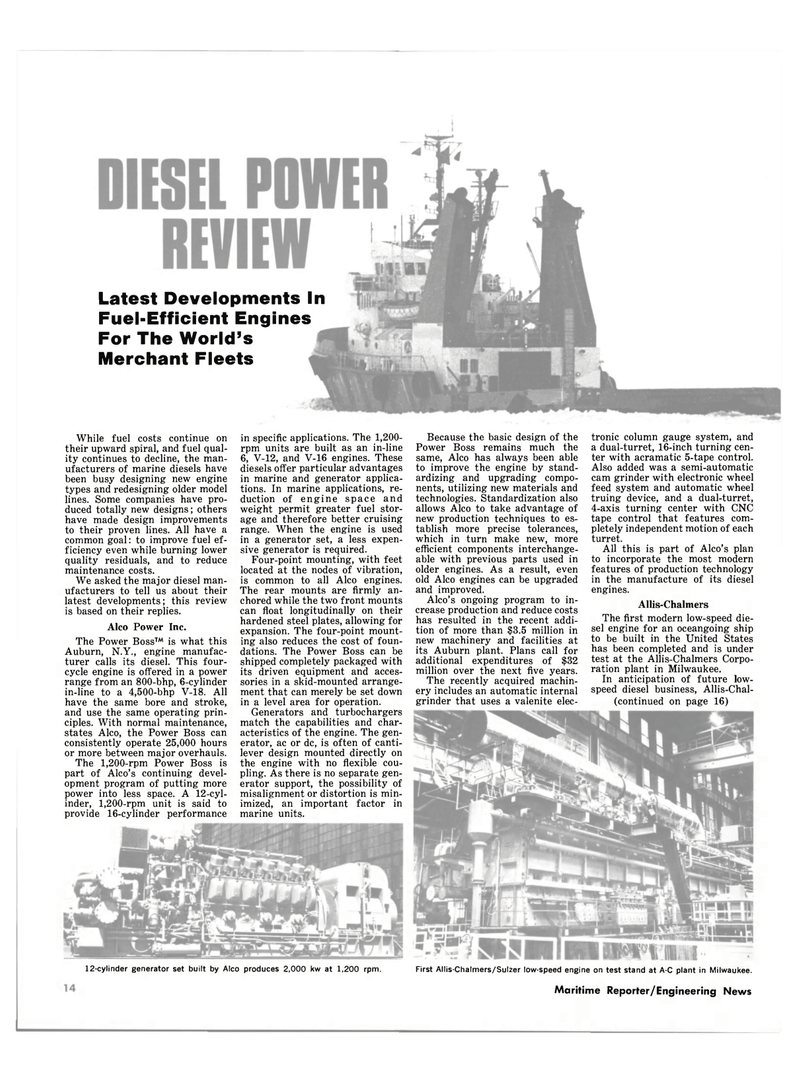
Page 12: of Maritime Reporter Magazine (October 15, 1980)
Read this page in Pdf, Flash or Html5 edition of October 15, 1980 Maritime Reporter Magazine
Latest Developments In
Fuel-Efficient Engines
For The World's
Merchant Fleets
While fuel costs continue on their upward spiral, and fuel qual- ity continues to decline, the man- ufacturers of marine diesels have been busy designing new engine types and redesigning older model lines. Some companies have pro- duced totally new designs; others have made design improvements to their proven lines. All have a common goal: to improve fuel ef- ficiency even while burning lower quality residuals, and to reduce maintenance costs.
We asked the major diesel man- ufacturers to tell us about their latest developments; this review is based on their replies.
Alco Power Inc.
The Power Boss™ is what this
Auburn, N.Y., engine manufac- turer calls its diesel. This four- cycle engine is offered in a power range from an 800-bhp, 6-cylinder in-line to a 4,500-bhp V-18. All have the same bore and stroke, and use the same operating prin- ciples. With normal maintenance, states Alco, the Power Boss can consistently operate 25,000 hours or more between major overhauls.
The 1,200-rpm Power Boss is part of Alco's continuing devel- opment program of putting more power into less space. A 12-cyl- inder, 1,200-rpm unit is said to provide 16-cylinder performance in specific applications. The 1,200- rpm units are built as an in-line 6, V-12, and V-16 engines. These diesels offer particular advantages in marine and generator applica- tions. In marine applications, re- duction of engine space and weight permit greater fuel stor- age and therefore better cruising range. When the engine is used in a generator set, a less expen- sive generator is required.
Four-point mounting, with feet located at the nodes of vibration, is common to all Alco engines.
The rear mounts are firmly an- chored while the two front mounts can float longitudinally on their hardened steel plates, allowing for expansion. The four-point mount- ing also reduces the cost of foun- dations. The Power Boss can be shipped completely packaged with its driven equipment and acces- sories in a skid-mounted arrange- ment that can merely be set down in a level area for operation.
Generators and turbochargers match the capabilities and char- acteristics of the engine. The gen- erator, ac or dc, is often of canti- lever design mounted directly on the engine with no flexible cou- pling. As there is no separate gen- erator support, the possibility of misalignment or distortion is min- imized, an important factor in marine units. 12-cylinder generator set built by Alco produces 2,000 kw at 1,200 rpm.
Because the basic design of the
Power Boss remains much the same, Alco has always been able to improve the engine by stand- ardizing and upgrading compo- nents, utilizing new materials and technologies. Standardization also allows Alco to take advantage of new production techniques to es- tablish more precise tolerances, which in turn make new, more efficient components interchange- able with previous parts used in older engines. As a result, even old Alco engines can be upgraded and improved.
Alco's ongoing program to in- crease production and reduce costs has resulted in the recent addi- tion of more than $3.5 million in new machinery and facilities at its Auburn plant. Plans call for additional expenditures of $32 million over the next five years.
The recently acquired machin- ery includes an automatic internal grinder that uses a valenite elec- tronic column gauge system, and a dual-turret, 16-inch turning cen- ter with acramatic 5-tape control.
Also added was a semi-automatic cam grinder with electronic wheel feed system and automatic wheel truing device, and a dual-turret, 4-axis turning center with CNC tape control that features com- pletely independent motion of each turret.
All this is part of Alco's plan to incorporate the most modern features of production technology in the manufacture of its diesel engines.
Allis-Chalmers
The first modern low-speed die- sel engine for an oceangoing ship to be built in the United States has been completed and is under test at the Allis-Chalmers Corpo- ration plant in Milwaukee.
In anticipation of future low- speed diesel business, Allis-Chal- (continued on page 16)
First Allis-Chalmers/Sulzer low-speed engine on test stand at A-C plant in Milwaukee.
Maritime Reporter/Engineering News

 11
11

 13
13
